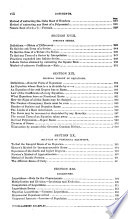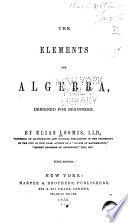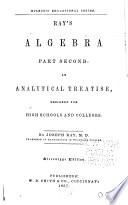 ... the product of the two, plus the square of the second. In the third case, we have (a + b) (a — 6) = a2 — b2. (3) That is, the product of the sum and difference of two quantities is equal to the difference of their squares. ... the product of the two, plus the square of the second. In the third case, we have (a + b) (a — 6) = a2 — b2. (3) That is, the product of the sum and difference of two quantities is equal to the difference of their squares.  A Treatise on Algebra - Page 204by Elias Loomis - 1868 - 384 pagesFull view A Treatise on Algebra - Page 204by Elias Loomis - 1868 - 384 pagesFull view - About this book
 | William Smyth - Algebra - 1851 - 272 pages
...let a be one of the quantities and b the other ; then (a + b) (a — b) = a? — b2. We thus learn that the product of the sum and difference of two...quantities is equal to the difference of their squareS. These propositions are demonstrated, in geometry, in another form, where it is shown, 1°, That if... | |
 | Joseph Ray - Algebra - 1848 - 250 pages
...^ But a+6 represents the sum of two quantities, and a — b, their difference ; hence, THEOREM III. The product of the sum and difference of two quantities, is equal to the difference of their squares. EXAMPLES. 1. (5+3)(5-3)=25-9=16=8X2. 2. (2a+6)(2a— 6)=4a*— V. 3. (2z+3y)(2x-3y)=4z'-9i/2. 4. (5a+46)(5a—... | |
 | Joseph Ray - Algebra - 1852 - 408 pages
...j02=4z2— 4ijr+y2. 3. (3x—5zy=9xi— 30xz+25z2. 4. (02— 3cx)2=o2z2— 6 ART. 8O. THEOREM III. — The product of the sum and difference of two quantities, is equal to the difference of tlieir squares. Let a represent one of the quantities, and 6 the other ; then o-|-i=their sum, and... | |
 | James William M'Gauley - 1854 - 284 pages
...+6 By a— b -ab—b2 Product a2— 62 The following formula is obtained from this example : — " the product of the sum and difference of two quantities, is equal to the difference of their squares." And, for the reason just given [35] it, also, is general. 37. EXAMPLE 3. — Multiply c — d By c... | |
 | Charles Davies, William Guy Peck - Mathematics - 1855 - 628 pages
...number of factors. The following are some of the properties of products with respect to their forms : 1. The product of the sum and difference of two quantities is equal to the difference of their squares ; that is, (x + y) (x — y) = x' — y'. 2. Twice the sum of two squares is equal to the sum of two... | |
 | Elias Loomis - Algebra - 1855 - 356 pages
...5— x/3 Product, 25-3=22, as required. These two examples are comprehended under the Rule in Art. 62, the product of the sum and difference of two quantities is equal to the difference of their squares. Ex. 3. Find a multiplier that shall make v/5+v/3 rational and determine the product. Ex. 4. Find a... | |
 | William Smyth - Algebra - 1855 - 370 pages
...quantity, minus the double product of the first by the second, plus the second power of the second. 5. The product of the sum and difference of two quantities is equal to the difference of their second powers. The questions, art. 15, will furnish additional exercises for the learner in stating... | |
 | Elias Loomis - Algebra - 1856 - 280 pages
...beginners often commit the mistake of putting the square of a— b equal to af—h\ THEOREM III. (67.) The product of the sum and difference of two quantities is equal to the difference of their squares. Thus, if we multiply a +b by a —b a'+ab -ab-b' we obtain the product a'- b'. Examples. Ex. 1. (3a+^b)(3a-4b)=9a'-16b\... | |
 | Harvey Goodwin - Mathematics - 1857 - 692 pages
...the following manner. It is easily seen by actual multiplication, that (a + 6) x (a - 6) = a- - b\ or that the product of the sum and difference of two...quantities is equal to the difference of their squares; a theorem which may be used in the multiplication of such quantities as those in the last example,... | |
 | Joseph Ray - Algebra - 1857 - 408 pages
...3)2=25— 30+9=4. 2. 3. (3x— 5z)2=9 4. (02— 3ca:)2=a2z2— Gacxz+QcW. ART. 8O. THEOREM III. — The product of the sum and difference of two quantities, is equal to the difference of their squares. Let a represent one of the quantities, and i the other ; then o-|-i=their sum, and a — i=their difference.... | |
| |